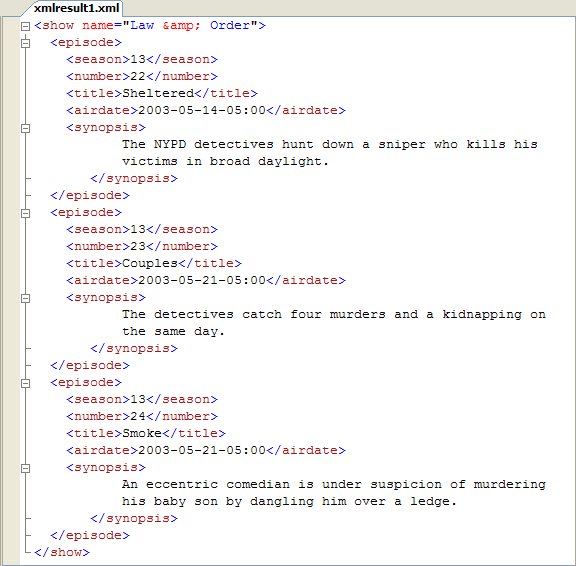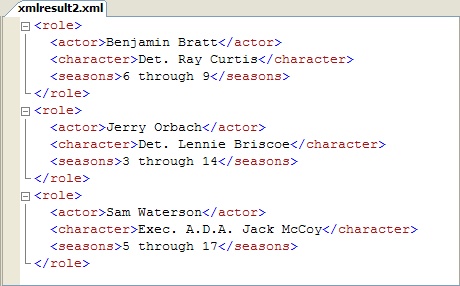SQL 2005: Enter XML
When SQL Server 2000 was released, it brought with it built-in T-SQL support for XML.
SQL Server 2000 XML support is cumbersome to work with and more than a little kludgy to
use.
SQL Server 2005 "kicks it up a notch" with a built-in XML
data type, XPath and XQuery support, and streamlined improvements to legacy XML tools.
This article is an introduction to the centerpiece of SQL Server 2005 XML support: the
new XML data type.
XML Documents and Fragments
The SQL Server 2005 XML data type can hold well-formed
XML documents or XML fragments. A well-formed XML document must satisfy the following
criteria:
- It must match the W3C "document" production,
- It must contain at least one element,
- It must have exactly one top-level element, known as the root element.
[This definition is from the W3C XML Standard 1.0 at
http://www.w3.org/TR/REC-xml/#NT-document.]
An XML fragment is defined by the W3C to mean "part of an XML document..."
XML fragments do not have to be well-formed. [See the W3C XML Fragment Interchange working
draft at http://www.w3.org/1999/06/WD-xml-fragment-19990630.html
for more information.]
For this example, I'm going to make one big assumption: that you're as big a fan
of Law & Order as I am. (Even if you're not, the sample will still get the
point across.) The sample in Listing 1 creates an XML
variable and loads it with a well-formed XML document containing L&O episode
summaries. It also loads a second XML variable with an
XML fragment containing a short list of characters from the series. The XML is implicitly
cast from nvarchar data to untyped XML
instances in both cases.
Listing 1. XML document vs. XML fragment
/* Will hold a well-formed XML document */
DECLARE @doc XML;
/* Populate the XML document */
SELECT @doc = N'<?XML version = "1.0" encoding = "UTF-16"?>
<show name = "Law & Order">
<episode>
<season>13</season>
<number>22</number>
<title>Sheltered</title>
<airdate>2003-05-14-05:00</airdate>
<synopsis>
The NYPD detectives hunt down a sniper who kills his
victims in broad daylight.
</synopsis>
</episode>
<episode>
<season>13</season>
<number>23</number>
<title>Couples</title>
<airdate>2003-05-21-05:00</airdate>
<synopsis>
The detectives catch four murders and a kidnapping on
the same day.
</synopsis>
</episode>
<episode>
<season>13</season>
<number>24</number>
<title>Smoke</title>
<airdate>2003-05-21-05:00</airdate>
<synopsis>
An eccentric comedian is under suspicion of murdering
his baby son by dangling him over a ledge.
</synopsis>
</episode>
</show>';
/* Select the XML document */
SELECT @doc;
/* Will hold an XML fragment */
DECLARE @frag XML;
/* Populate the document fragment */
SELECT @frag = N'
<role>
<actor>Benjamin Bratt</actor>
<character>Det. Ray Curtis</character>
<seasons>6 through 9</seasons>
</role>
<role>
<actor>Jerry Orbach</actor>
<character>Det. Lennie Briscoe</character>
<seasons>3 through 14</seasons>
</role>
<role>
<actor>Sam Waterson</actor>
<character>Exec. A.D.A. Jack McCoy</character>
<seasons>5 through 17</seasons>
</role>';
/* Select the XML fragment */
SELECT @frag;
|
| NOTE: You might notice the airdate element in the well-formed XML document contains a date in the format "2003-05-21-05:00". This is a standard date format defined by ISO 8601. SQL Server's XML implementation requires that date and time data (xs:date, xs:time, xs:dateTime types) in a typed XML document must have a time zone attached (we'll discuss typed versus untyped XML later on). The timezone "Z" is the "Zero Meridian", or UTC time. In the example, the time zone "-05:00" is UTC minus 5 hours, or U.S. Eastern Standard Time. |
The results of the sample in Listing 1 are shown in Figures 1 and 2 below.
Figure 1. Law & Order Episodes in XML format

Figure 2. The cast members in XML format

To and From XML
The XML data type can be used anywhere that other SQL data
types are used. You can, for instance:
- declare an XML variable (as we did above),
- declare a column of XML type in a table,
- declare XML parameters for stored procedures and
user-defined functions,
- define the return value of a scalar user-defined function as XML,
- implicitly or explicitly cast to and from XML, according to the following rules you can:
- implicitly cast values from char, varchar,
nchar, nvarchar, binary,
varbinary, ntext, or text
to the XML data type.
- explicitly cast XML values to char,
varchar, nchar, nvarchar,
binary, or varbinary data types using the
CAST function.
- explicitly cast an XML instance to another XML instance.
- implicitly cast an untyped XML instance to another untyped
XML instance, a typed XML instance
to an untyped instance, or an untyped XML instance to typed
instance.
- implicitly cast values from char, varchar,
Most of your conversions will probably be casts from varchar,
nvarchar, and varbinary data to
an XML instance, as we did in the sample code in Listing 1; but the
other casting options are there when (and if) you need them.
If you cast from varchar to XML,
the XML is encoded with one-byte characters. If you declare an XML encoding in the prolog
of the XML, that encoding will be used. This example prolog declares a UTF-8 encoding for
your varchar source:
<?XML encoding = "UTF-8" ?>
If not explicitly specified in the prolog, the code page of the source string will be
used (if there is one associated). If you're casting nvarchar
to XML, UTF-16 encoding is used. You can include an encoding in
your source prolog like this (if you choose to):
<?XML encoding = "UTF-16" ?>
But it's not required.
If you're casting from varbinary your XML needs to contain
the byte-order mark (BOM) or the UTF-16 encoding declaration (or both) if your data
is Unicode. Otherwise you can use a UTF-8 encoding declaration or just leave the encoding
off.
So What Is "Typed" XML?
We'll start this section by describing "untyped" XML. Untyped XML is
standard XML; that is to say take any old data, entitize it (see below), slap some tags
around it and voila -- instant XML (in reality I can only hope you put more planning than
that into your *real* XML, but who's to say?) Untyped XML is not associated with an XML
Schema, and as the name indicates it has no type information associated with it. The
examples in Listing 1 were untyped XML.
| NOTE: "Entitizing" your XML is the process of converting certain special characters to XML entities. Characters like "<", "&", etc., have special meaning in XML and have to be converted to entities like "<" and ">". |
Typed XML is XML associated with an XML Schema collection. An XML Schema
collection is a group of XML Schema definitions, each definition containing type
information for the elements of an XML document. Typed XML provides advantages over
untyped XML including:
- validation and typing of your XML data,
- more efficient querying of your XML data,
- the ability to perform data-type specific operations on your XML data, like math
operations on numeric data.
One disadvantage is that you lose some of the flexibility of untyped XML, where
you can stick data of any type in any element. Consider the following simple untyped
XML document:
<numbers> <number>6.00</number> <number>six</number> <number>VI</number> </numbers> |
Of course, most client applications wouldn't be equipped to deal with alternating
Arabic numerals, English words, and Roman numerals to represent numbers in an XML document.
But, for those times when your business rules absolutely demand it, untyped XML can do the
job. In Listing 2, we'll create an XML Schema collection for the well-formed XML document
we created in Listing 1.
Listing 2. Creating an XML Schema collection
CREATE XML SCHEMA COLLECTION ShowSchema AS N'<?XML version="1.0" encoding="UTF-16"?>
<xs:schema xmlns="http://schemas.sqlservercentral.com/ShowSchema"
xmlns:xs="http://www.w3.org/2001/XMLSchema">
<xs:element name="show">
<xs:complexType>
<xs:sequence>
<xs:element name="episode" minOccurs="1" maxOccurs="unbounded">
<xs:complexType>
<xs:sequence>
<xs:element name="season" minOccurs="1" maxOccurs="1" type="xs:integer"/>
<xs:element name="number" minOccurs="1" maxOccurs="1" type="xs:integer"/>
<xs:element name="title" minOccurs="1" maxOccurs="1" type="xs:string"/>
<xs:element name="airdate" minOccurs="1" maxOccurs="1" type="xs:date"/>
<xs:element name="synopsis" minOccurs="1" maxOccurs="1" type="xs:string"/>
</xs:sequence>
</xs:complexType>
</xs:element>
</xs:sequence>
<xs:attribute name="name" type="xs:string" use="required"/>
</xs:complexType>
</xs:element>
</xs:schema>';
GO
|
A full description of the intricacies of XML Schema could fill an entire book, and
is well beyond the scope of this introductory article. Suffice it to say the XML schema
here is used to validate the elements of the document, ensuring that they:
- appear the correct number of times,
- are nested properly and occur in the proper sequence,
- have required attributes, and
- are of the proper type (integer, string, date, etc.)
| NOTE: The XML Schema datatypes are described in detail on the W3C website, in the XML Schema Part 2: Datatypes Second Edition specification, |
Once the XML Schema has been registered with the XML Schema collection in SQL Server
you can use it to create typed XML instances. Listing 3 uses the XML document and
XML Schema collection from the previous examples to create a typed XML instance.
Listing 3. Creating a typed XML instance
/* Will hold a well-formed XML document */
DECLARE @doc XML (DOCUMENT ShowSchema);
/* Populate the XML document */
SELECT @doc = N'<?XML version="1.0" encoding="UTF-16"?>
<show name = "Law & Order">
<episode>
<season>13</season>
<number>22</number>
<title>Sheltered</title>
<airdate>2003-05-14-05:00</airdate>
<synopsis>
The NYPD detectives hunt down a sniper who kills his
victims in broad daylight.
</synopsis>
</episode>
<episode>
<season>13</season>
<number>23</number>
<title>Couples</title>
<airdate>2003-05-21-05:00</airdate>
<synopsis>
The detectives catch four murders and a kidnapping on
the same day.
</synopsis>
</episode>
<episode>
<season>13</season>
<number>24</number>
<title>Smoke</title>
<airdate>2003-05-21-05:00</airdate>
<synopsis>
An eccentric comedian is under suspicion of murdering his
baby son by dangling him over a ledge.
</synopsis>
</episode>
</show>';
/* Select the XML document */
SELECT @doc;
|
The typed XML document has to conform to the content rules specified in the XML Schema.
Some of the content rules we specified in the example include:
- show is the root element of the XML document, and
it has a required attribute name,
- the show element can contain one or more episode elements,
- each episode element must contain exactly one of each of the following elements, in this order:
- season which must contain an xs:integer value,
- number which must contain an xs:integer value,
- title which contains an xs:string value,
- airdate which must contain an xs:date value, and
- synopsis which contains an xs:string value
An XML document that complies with an XML Schema is a "valid" XML document. You
can change the XML document to make it invalid. Try changing the contents of
a number element to a non-integer value or move some of
the elements out of order. SQL Server will reject the XML if it does not conform to the
XML Schema in the collection.
Facets
Observant readers might have noticed the following line in Listing 3:
DECLARE @doc XML (DOCUMENT ShowSchema);
This line declares an XML variable and associates it with the XML Schema collection we
named ShowSchema. You might have also noticed the word
DOCUMENT in parentheses right before the XML Schema collection
name. The DOCUMENT keyword indicates a "facet",
which tells SQL Server what type of XML the variable (or column) can hold. The available
facets are DOCUMENT, which indicates that the XML instance
must be a well-formed document (only one top-level, or root, element), and
CONTENT, which indicates that the XML can be an XML
fragment. The default facet is CONTENT.
Tune in Next Time
This article introduced the new SQL Server 2005 XML
data type. In the next article we'll take a look at the
XML data type's query() method
and SQL Server 2005's XQuery support.
©2007 by Michael Coles, regular contributor to SQLServerCentral and author of the upcoming Apress book Pro T-SQL 2005 Programmer's Guide (April 2007). |



